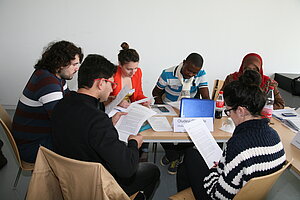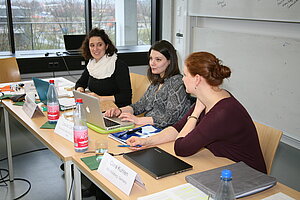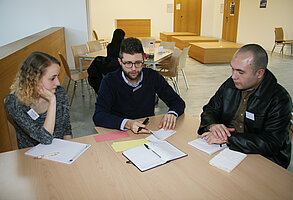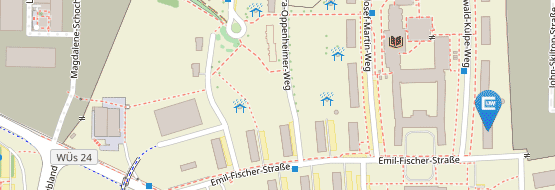Case Study for Teaching in Higher Education



Aims of the method/strategy
The aim of the case study group work is to offer students:
- real-world examples,
- opportunities to apply the theories they have learnt in the classroom (content) to real-life examples,
- opportunities to reflect on their learning (theories)
- opportunities to build their own new learning (application of content to the example) in an interactive setting with peers (learning by doing),
- opportunities to understand that there might be multiple solutions to one case/multiple possible decisions to solve an issue/different point of views,
- opportunities to acquire (social) organisational skills,
- opportunities to connect classroom work to a challenge in the labour market.
Because of all these possible achievements, students can develop critical thinking (multiple convergent or divergent questions are seen as tools to enhance students’ critical thinking skills), communication skills, teambuilding skills, ability to reflect on their actions and skills as prospective professionals in the field of education and care, real considerations of the real problem in the context of the labour market.
On the link between case study and critical thinking:
Critical thinking skills can be achieved in reading (and re-reading, by exchanging points of view on the meaning of the case study), discussion (identification of main facts, main actors, main issues to be solved), analysis (students try to answer the questions posed by the teacher, who aims to guide students in the solution of the assignment), presentation of the case study, that is, in each of the phases of the ‘case study work group’ practice.
For example: Recognising the existence of multiple divergent and convergent questions on a single case study can enhance students’ high-level reasoning skills. When the teacher/facilitator supports students in their learning process by interchanging ideas, then critical thinking skills can improve. The same applies during the final common presentation, when the teacher asks students questions about their work.
For example: The challenge of a social company could be the task for the group. If the group can read the situation (needs of the company), can discuss the situation (some solutions), can analyse the solution with the possibilities (to interview the real situation and to understand the environment of the challenge), they can try to arrive at a definitive solution presenting a prototype of the problem/challenge.
Setting
Room
Type and name of the course, curriculum, number of students in which the teaching practice was exercised:
Master’s degree in adult education, lifelong learning, and pedagogical sciences, course on methods in educational research, typical enrolment of around 50 students.
Description of the method/strategy
The teacher asks students to organise themselves in small groups (from 4 to 6 students each). In an international context, it is possible to create international groups with students coming from many countries. In this case, English will be the language used. It is possible to frame the problems in an international context: It will be necessary to work on the environmental language and intercultural issues. Both are challenges for the groups and for the teacher.
Students are mostly free to choose their partners for the group work. Usually, groups are formed on the basis of two criteria:
- persons sitting next to you,
- randomly mixed up groups,
- groups according to friendship,
- groups according to interest (topic of the project),
- groups according to geographical address (in order to ease the homework),
- groups according to an intercultural situation (challenge).
The teacher/instructor/facilitator:
- creates one case study and asks groups to analyse it,
- gives 10-15 minutes (or adequate time) to work through the case.
- walks around the room and answers the groups’ questions while they are working,
- indicates, at the end of the group work, how the presentation should be done: each student should play a role in the presentation, that is, each student should present at least a part of the work (this has to be agreed among group members before the presentation), although each of them should be able to answer questions from the teacher/facilitator, no matter what they presented before.
- calls on each group and asks students to share their work.
No evaluation is given. The task is achieved if every student is able to explain the analysis done (i.e. if everyone is able to describe the phases the group went through, to verbalise the research process and the ideas debated in the group or the discussion performed to arrive to a common shared analysis of the case study) using coherent and scientific language and adopting the right body language, standing and feeling self-confident.
Materials required
- Posters, post-its, pencils, markers, felt-tip pen, paper
Origin and theoretical framework
Student-centred learning and teaching methods, work-related learning
Risks and advantages
Advantages:
- Real-life situations and/or concrete examples are offered to students; improvement of critical thinking, communication, tolerance, and inclusion:
- Students get to know the labour market through real work and, above all, arrive at a solution by creating a prototype (a product);
Risks:
- It may be difficult for some students more used to teacher-centred learning; the teacher may face difficulties finding concrete examples; time management may be a challenge for students.
- It may create a difficult situation in class because it is very complex to think about solutions far from students’ own direct experience.
Possible variations
- International Winter School of Wurzburg (COMPALL project) in the year 2015-2018
- International Summer School of Belgrade 2016 (ESRALE project)
- PhD School of Education and Psychology, University of Florence
Contact persons
Vanna Boffo ( vanna.boffo@unifi.it )
Recommendation
Projects developed by the University’ professors could be good case studies.


